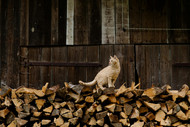Working Whiskers: Exploring the Diverse Jobs of Working Cats
Posted by Wally Jack on 5th Mar 2024

Cats haven't just been lounging around on windowsills and demanding chin scratches throughout history. These furry friends have a long and fascinating history of working alongside humans in a variety of professions. From keeping historic buildings rodent-free to providing emotional support in hospitals, cats have proven their adaptability and value in the workforce. So, let's delve into the world of working whiskers and explore the diverse jobs these feline colleagues hold.
The OG Mousers: Cats as Guardians of Grain
The relationship between cats and humans likely began with a shared interest: pest control. As humans transitioned from hunter-gatherers to farmers, they started storing grains, which attracted unwelcome guests – rodents. Enter the cat, a natural predator with exceptional hunting skills and a keen sense of smell. Evidence suggests cats were domesticated in the Near East around 7,500 BC, likely coinciding with the rise of agriculture. These early feline companions weren't pampered pets, but valued partners in protecting precious food stores.
This tradition of using cats for pest control continued for millennia. Ancient Egyptians revered cats as protectors, often depicting them in hieroglyphs and sculptures. Ships carried cats on long voyages to keep rats and mice from devouring valuable supplies. As civilizations flourished, so did the need for rodent control in granaries, libraries, and other buildings filled with potential rodent buffets. Cats became a fixture in these settings, earning the well-deserved title of "mousers."
Even today, the legacy of the mouser lives on. Many historic buildings, like museums and libraries, employ cats to keep rodent populations in check. The British Royal Family famously employs a dedicated team of mousers to patrol Buckingham Palace. These felines are more than just pest control; they're furry ambassadors, adding a touch of charm and history to these esteemed institutions.
Beyond Mousing: The Expanding Roles of Working Cats
While pest control remains a key function, cats have branched out into other professions, showcasing their unique skills and temperament. Here are some fascinating examples of working cats today:
- Therapy Cats: Cats are known for their calming presence and ability to purr – a sound scientifically proven to lower stress and anxiety. Hospitals, nursing homes, and even some college campuses utilize therapy cats to provide emotional support to patients and students. Studies have shown interacting with cats can reduce blood pressure, improve mood, and even lessen feelings of loneliness.
- Working Sheepdogs (…of the Feline Kind): Believe it or not, some cats exhibit herding instincts! Border Collies aren't the only ones who can manage a flock. In New Zealand, some farms have successfully employed cats to herd sheep, particularly in smaller flocks. Their agility and quick reflexes make them surprisingly effective at keeping the sheep in line.
- Barn Cats: While not technically employed, barn cats play a crucial role in maintaining pest control in agricultural settings. Unlike mousers in protected buildings, barn cats live a semi-feral lifestyle, keeping rodent populations under control in barns and outbuildings. This helps protect crops and livestock from pests and disease.
- Detection Cats: Cats have an incredibly powerful sense of smell, exceeding even that of dogs in some areas. Researchers are exploring the potential of training cats to detect specific scents, such as explosives or medical conditions. While still in its early stages, this could lead to new applications for feline detection skills.
The Skills that Make Cats Remarkable Workers
So, what exactly makes cats such effective workers?
- Natural-Born Hunters: Their keen senses of sight, smell, and hearing give them a significant advantage in pest control and detection work.
- Stealthy and Agile: Cats are masters of silent movement, allowing them to approach prey or navigate tight spaces undetected.
- Independent and Low-Maintenance: Unlike dogs, cats require less training and supervision, making them a cost-effective pest control solution.
- Calm and Adaptable: Many cats thrive in different environments, adjusting well to the demands of their particular job.
However, it's important to remember that not all cats are suited for working life. Some felines are more timid or independent and may not adapt well to busy environments or unfamiliar people. It's crucial to carefully assess a cat's temperament and personality before placing them in a working situation.
Ethical Considerations of Working Cats
While the benefits of working cats are undeniable, ethical considerations are paramount. Here are some key points to ensure the well-being of feline employees:
- Proper Selection and Training: Cats chosen for work environments should undergo temperament testing and training specific to their role. Their natural behaviors should be utilized, not forced.
- Adequate Care and Enrichment: Working cats still need proper veterinary care, nutritious food, and opportunities for playtime and socialization.
- Respectful Work Environment: Working cats should not be subjected to harsh conditions, excessive stress, or forced interaction. Their working hours should be reasonable, and they should have access to comfortable shelters and safe spaces to retreat when needed.
Working Together: A Purrfect Partnership
Cats have earned their place alongside humans for millennia, contributing their unique skills and companionship in various capacities. From the humble mouser to the innovative therapy cat, these furry colleagues remind us of the power of collaboration and the diverse roles animals can play in our lives. As we continue to explore the potential of working cats, ethical considerations and respect for their well-being must remain at the forefront. By valuing their contributions and ensuring their welfare, we can create a purrfect partnership that benefits both humans and our feline friends.




